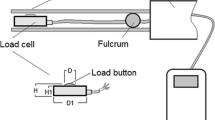Abstract
The pinching forces of crustaceans are in many respects analogous to the biting forces of vertebrates. We examined the effects of body size and chelae size and shape, on the closing forces of the fiddler crab, Uca pugilator, and the crayfish, Procambarus clarkii. We hypothesized that the allometric relationships would be similar among species, and comparable to those reported for other decapod crustaceans. We further hypothesized that the scaling of the closing forces of crustaceans, with respect to body size and with the geometry of the pinching or biting structures, would be similar to that of vertebrates. We found that pinching forces increased with body mass, claw dimensions, and claw mass in U. pugilator, but only with claw height and claw mass in P. clarkii. Contraction time increased with body mass for both species combined, whereas contraction speed decreased. Pooled data for these and 17 other species of decapod crustacean revealed a positive correlation between the pinching force and body mass with a scaling exponent of 0.71. These data are remarkably comparable to the values on closing forces of vertebrate jaws, with the pooled data having a scaling exponent of 0.58, slightly below the value of 0.67 predicted for geometric similarity. Maximum closing forces vary tremendously among both crustaceans and animals in general, with body size and food habits being among the most important determining factors.








Similar content being viewed by others
References
Alexander RM (1985) The maximum forces exerted by animals. J Exp Biol 115:231–238
Anderson JF, Rahn H, Prange HD (1979) Scaling of supportive tissue mass. Q Rev Biol 54:139–148
Björklund M (1997) Are ‘comparative methods’ always necessary? Oikos 80:607–613
Crane C (1975) Fiddler crabs of the world Ocypodidae: genus Uca. Princeton University Press, Princeton
Elner RW, Campbell A (1981) Force, function and mechanical advantage in the chelae of the American lobster Homarus americanus (Decapoda: Crustacea). J Zool 193:269–286
Felsenstein J (1985) Phylogenies and the comparative method. Am Nat 125:1–15
Gittleman JL, Luh HK (1994) Phylogeny, evolutionary models and comparative methods: a simulation study. In: Eggleton P, Vane-Wright R (eds) Phylogenetics and ecology. Academic, London, pp 103–122
Hartnoll RG (1974) Variation in growth pattern between some secondary sexual characters in crabs (Decapoda: Brachyura). Crustaceana 27:131–136
Herrel A, O’Reilly JC (2006) Ontogenetic scaling of bite force in lizards and turtles. Physiol Biochem Zool 79:31–42
Herrel A, Spithoven L, Van Damme R, De Vree F (1999) Sexual dimorphism of head size in Gallotia galloti: testing the niche divergence hypothesis by functional analyses. Funct Ecol 13:289–297
Herrel A, De Grauw E, Lemos-Espinal JA (2001a) Head shape and bite performance in xenosaurid lizards. J Exp Zool 290:101–107
Herrel A, Van Damme R, Vanhooydonck B, De Vree F (2001b) The implications of bite performance for diet in two species of lacertid lizards. Can J Zool 79:662–670
Herrel A, O’Reilly JC, Richmond AM (2002) Evolution of bite performance in turtles. J Evol Biol 15:1083–1094
Huber DR, Eason TG, Hueter RE, Motita PJ (2005) Analysis of the bite force and mechanical design of the feeding mechanism of the durophagous horn shark Heterodontus francisci. J Exp Biol 208:3553–3571
Korff WL, Wainwright PC (2004) Motor pattern control for increasing crushing force in the striped burrfish (Chilomycterus schoepfi). Zoology 107:335–346
Levinton JS, Allen BJ (2005) The paradox of the weakening combatant: trade-off between closing force and gripping speed in a sexually selected combat structure. Funct Ecol 19:159–165
Levinton JS, Judge ML (1993) The relationship of closing force to body size for the major claw of Uca pugnax (Decapoda: Ocypodidae). Funct Ecol 7:339–345
Levinton JS, Judge ML, Kurdziel JP (1995) Functional differences between the major and minor claws of fiddler crabs (Uca, family Ocypodidae, order Decapoda, subphylum Crustacea): a result of selection or developmental constraint? J Exp Mar Biol Ecol 193:147–160
Losos JB (1999) Uncertainty in the recognition of ancestral character states and limitations on the use of phylogenetic comparative methods. Anim Behav 58:1319–1324
Mitchell SC, Demont ME (2004) Modeling torque generation by the mero-carpopodite joint of the American lobster and the snow crab. Mar Fresh Behav Physiol 37:235–251
Schenk SC, Wainwright PC (2001) Dimorphism and the functional basis of claw strength in six brachyuran crabs. J Zool 255:105–119
Schmidt-Nielsen K (1997) Animal physiology adaptation and environment, 5th edn. Cambridge University Press, Cambridge
Taylor GM (2001) The evolution of armament strength: evidence for a constraint on the biting performance of claws of durophagous decapods. Evolution 55:550–560
Vermeij GJ (1977) Patterns in crab claw size: the geography of crushing. Syst Zool 26:138–151
Verwaijen D, Van Damme R, Herrel A (2002) Relationship between head size, bite force, prey handling efficiency and diet in two sympatric lizards. Funct Ecol 16:842–850
Warner GF, Jones AR (1976) Leverage and muscle type in crab chelae (Crustacea: Brachyura). J Zool 180:57–68
Wroe S, McHenry C, Thomason J (2005) Bite club: comparative bite force in big biting mammals and the prediction of predatory behaviour in fossil taxa. Proc R Soc Lond B 272:619–625
Yamada SB, Boulding EG (1998) Claw morphology, prey size selection and foraging efficiency in generalist and specialist shell-breaking crabs. J Exp Mar Biol Ecol 220:191–211
Acknowledgments
We wish to thank A. Richmond for assistance with the design of the force-measuring apparatus and with husbandry. We also wish to thank L. Torres and two anonymous reviewers for comments on an earlier version of this manuscript. This research was undertaken in compliance with the Animal Care guidelines from Miami University.
Author information
Authors and Affiliations
Corresponding author
Additional information
Communicated by G. Heldmaier.
Rights and permissions
About this article
Cite this article
Claussen, D.L., Gerald, G.W., Kotcher, J.E. et al. Pinching forces in crayfish and fiddler crabs, and comparisons with the closing forces of other animals. J Comp Physiol B 178, 333–342 (2008). https://doi.org/10.1007/s00360-007-0226-8
Received:
Revised:
Accepted:
Published:
Issue Date:
DOI: https://doi.org/10.1007/s00360-007-0226-8




